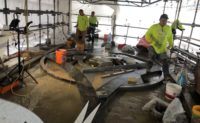• Document project changes. Catching a mistake before it becomes a built construction error is better than having to defend your design after the fact. Design professionals should stay involved throughout construction to help develop design changes, review component shop drawings and observe as-built construction.
• When possible, use peer review to optimize design. Such reviews are particularly helpful for larger, more complex structures.
• Be cautious when entering into professional services agreements. They should clearly define the scope of services and include an appropriate standard-of-care provision. It should not include superlatives, such as “best” or “most,” which can be construed as guarantees, warrantees or services.
Building codes should continue to be refined. As Klein and his Wiss Janney Elstner colleagues confirm, knowledge is growing about the effects of heavy snow loads and the damage inflicted from uneven drifting between roofs of varying heights and sizes. Extreme weather has something to teach designers.
Experience shows that good practices will not always keep designers from being sued—only sound risk management can help do that.
Lionel Béjean, who is based in Washington, D.C., is part of the Beazley Group underwriting team for specialty insurance lines for architects and engineers. He can be reached at 215-446-8449.


Post a comment to this article
Report Abusive Comment